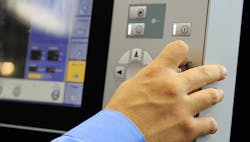A human-machine interface (HMI) can be utilized in hazardous environments where there would be a high risk of injury and a significant need for automation. HMI technology enables us to control and analyze the machine's operations without entering the machine's hazardous area. This minimizes the probability of injury or accident.
The hazardous-area classification system is used where flammable liquids, dust or gases might be present. This classification standard can be found in the American Society for Testing and Materials (ASTM) standard F 1249-91 and the European Standard (EN) 14765:2002. The classification of hazardous zones can be put into two major groups. The first group is for industries that are below ground, such as mining. The other category is for work completed on the surface, including construction and agriculture.
Also read: Hazardous locations require special enclosure considerations
Mining: The installation of electrical equipment in mines is a safety concern. The most common gas in coal mines is firedamp, which can be ignited by any spark or flame. This gas, also known as methane, is highly explosive when mixed with air under particular conditions. The installation of electrical equipment in mines during the extraction process has raised safety concerns since it generates sparks that might ignite a firedamp.
Surface industry: There are various risks to be aware of in an explosive gas atmosphere. One of them is electrical systems, as any spark can ignite the gas and cause a fire. When using electrical equipment in this sort of scenario, it's vital to know the maximum voltage that may be used. An explosion may occur if the voltage exceeds this limit.
Electrical equipment for explosive dust environments is often built for usage in locations with flammable dust in the air. Power distribution panels, switchgear and control panels are the most prevalent forms of electrical equipment found in these settings. This sort of equipment must be able to resist the consequences of a detonation or explosion.
There are several types of equipment that may be employed within these hazardous area zones to eliminate or substantially reduce the possibility of an explosion. This equipment must be designed and developed in compliance with specific construction criteria known as protective ideas.
Construction of HMIs in hazardous areas
One of the ways an HMI can be in a hazardous area is with explosion-proof enclosures, designed to protect people and machines. The explosion-proof enclosure is used to protect against explosions in mines, chemical plants, oil refineries, military bases or areas where there's a risk.
The gas grouping and maximum surface temperature are used to classify enclosures. The categorization is divided into four categories: A, B, C and D. Group A gases are nonflammable, while Group D gases are combustible. The maximum surface temperature of Group B gases is less than 200 °C, while Group C gases have a maximum surface temperature larger than 200 °C.
What are some installation and maintenance problems with these enclosures? A medium-weight enclosure is quite heavy, and its installation might be complicated mechanically and structurally; corrosive air conditions such as those found in chemical or petrochemical factories or on oil platforms necessitate the use of stainless steel or bronze. Cable entry needs specific setup reductions, cable clamps, conduits, metal-clad cable and sealing; condensation inside the enclosure may pose complications in a very humid environment. Also, the enclosure cannot be opened while the device is in use, which may make maintenance and inspection more difficult.
Things to look for when picking HMI for hazardous areas
When looking to purchase an HMI for hazardous areas, here are some things to look for. Approvals from all across the world for usage in dangerous environments, Class I, Div. 2, groups A, B, C and D, T4; Class I, Zone 2 and UL/CUL listed, IEC 60079-0, IEC 60079-11; and IEC 60079-15 compliance, field-replaceable displays and box PC components are designed in a modular fashion, temperatures vary from -20 to +60 °C, reduced downtime with a dedicated disaster recovery drive; and the enclosure is made of stainless steel and is NEMA 4X and IP66-rated. Some user-friendly features that are not needed but are nice to have are:
- LCD screens that can be viewed in the sun and are UV-protected
- operation of projected capacitive touch with thin gloves
- Industry 4.0 and Industrial Internet of Things (IIoT) applications are enabled by an open platform.
It is very important to be aware of the hazards and volatility of the installation site before choosing a certain manufacturer for the HMI.
About the Author
Shawn Cox
Contributing Editor
Shawn Cox is a licensed master electrician/PLC programmer. He was co-owner/operator of Bobby Cox Electric for 15 years and is currently employed by BMW Manufacturing as an ESA. Contact him at [email protected].

Leaders relevant to this article:


